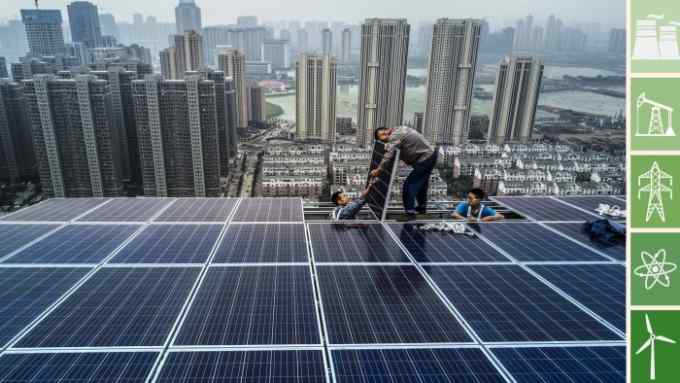Coal fades in developed world but is far from dead in Asia

Roula Khalaf, Editor of the FT, selects her favourite stories in this weekly newsletter.
In the energy business, perceptions of change often run ahead of reality. The 19th century is widely thought of as the Age of Coal. However, as environmental scientist Vaclav Smil points out, the dominant sources of total fuel use worldwide were wood, charcoal and straw.
On that basis, it was the 20th century that was the true Age of Coal. The lesson, Mr Smil told a conference of energy experts and policymakers in 2013, is that “these energy transitions to higher quality fuels . . . take a very, very long time”.
The survival of the global coal industry into the 21st century proves his point.
World coal use rose in 2017 for the first time in three years, and may well rise again in 2018. Prices for thermal coal used for power generation have risen strongly in recent months, driven by high temperatures in China and other Asian countries that have increased demand for air-conditioning and hence for electricity.
While coal use for power appears to have peaked in developed countries, there is still growth in many emerging economies, particularly in south-east Asia, for the most carbon-intensive fuel available.
The outlook for China, which accounts for a little under half the world’s coal demand, is uncertain: the government is making efforts to curb emissions from coal, but power generators are still seeking to build new plants.
Coal remains an appealing solution for countries that need to meet fast-rising demand for electricity, are seeking to minimise costs, and are not setting reductions in greenhouse gas emissions as the prime objective of energy policy.
For many emerging economies, the big concern about coal is not carbon dioxide but the nitrogen and sulphur oxides that cause local pollution.
Renewable energy is increasingly competitive against coal. “The costs of solar and wind power have now fallen to the point where in many parts of Asia they can compete against coal plants, without any need for additional subsidies,” says Richard Lancaster, chief executive of Hong Kong-based utility CLP Holdings, which also operates power plants in China, India and other Asian countries.
Despite the growth of renewables as a low-cost source of electricity, emerging economies are still investing in coal to ensure 24-hour supply and to support industrial development.
Vietnam, for example, plans to supply 10.7 per cent of its power demand from renewable sources excluding hydro power in 2030, up from 6.5 per cent in 2020. However, over the same period the country’s coal use is also expected to soar, as new plants are built to meet surging demand for electricity. The government plans to have 850 megawatts of solar capacity and 800MW of wind by 2020. However, there are about 15,000MW of coal-fired plants in development but not yet permitted, 8,750MW permitted, and 10,640MW under construction, according to CoalSwarm, an environmental research group.

Natural gas is a less carbon-intensive fossil fuel but it remains relatively expensive in Asia: cargoes of liquefied natural gas have been selling for almost $10 per million British Thermal Units, compared with a US benchmark price of just under $3 per mBTU. While there has been a shift from coal to gas for power generation in the US, the trend has gone the other way in south-east Asia. Unless gas prices fall very sharply it is hard to see that trend being reversed.
The result is that coal use globally is expected to rise slowly over the next few years, in spite of declines in the US and Europe. The International Energy Agency’s forecasts out to 2022, published at the end of last year, show projected declines in coal demand of 11m tonnes per year for China, 30m tonnes per year for European countries that are in the OECD, a club of mostly rich nations, and 37m tonnes per year for North America. Those declines are more than offset, however, by increases of 135m tonnes per year for India and 70m tonnes per year for the members of the Association of Southeast Asian Nations (Asean), which includes Vietnam.
That forecast for India could turn out to be too high, depending on whether the government decides whether to bail out financially-distressed coal plants. But even if the rate of growth in demand for coal in India slows further, the outlook for global coal demand over the next few years is likely to be roughly flat.
The shift in global coal-fired generation of electricity from the US and Europe to more modern power stations in Asia could mean that greenhouse gas emissions from coal still fall. Many of the new plants in Asia use “high efficiency low emissions” (HELE) technologies, which can achieve significant reductions compared with the older plants in developed countries. Benjamin Sporton of the World Coal Association, which represents international producers, points out that some Asian countries are using the adoption of HELE plants as part of their strategy for meeting pledges to curb emissions under the Paris climate agreement.
The Age of Coal may be entering its twilight years. But coal, as a contributor to global energy supplies, is some way from a museum piece just yet.
Explore the rest of our stories on Energy Producers
- Solar and wind power surge marks production shift
- Big Oil harnesses power of data analysis to ensure survival
- High costs and renewables challenge the case for nuclear power
- Natural gas vies for role in low-carbon economy
- Opinion: Forecasters have an awful record in predicting energy markets

Comments